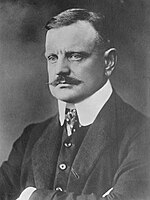Swanwhite (Sibelius)
| Swanwhite | |
|---|---|
| Incidental music by Jean Sibelius | |
 The composer in 1913 | |
| Catalogue | JS 189 |
| Opus | 54 |
| Composed | 1908 |
| Performed | 8 April 1908 |
| Scoring | orchestra |

Swanwhite (Swedish: Svanevit), JS 189, is incidental music for orchestra by Jean Sibelius for a play of the same name by August Strindberg. It consists of a horn call and thirteen other movements. Sibelius completed it in 1908 and conducted the first performance at Helsinki's Swedish Theatre on 8 April 1908. In 1909, Sibelius drew from it a suite in seven movements, Op. 54.[1]
Background
[edit]Swedish actress Harriet Bosse had been impressed by one of Sibelius' earlier works, incidental music for the play Pelléas and Mélisande, after having played the role of Mélisande in 1906. Thus, Bosse suggested to Strindberg for Sibelius to score music to his play, Swanwhite.[1]
The play Swanwhite was written in 1902. It follows the tale of a princess, Swanwhite (that lives with her father, the Duke, and her evil stepmother), who is set to be married to a neighbouring king, but instead falls in love with his messenger, a prince. Although their relationship is approved by their late mothers, represented by swans, Swanwhite's stepmother works to sabotage it.[2]
Structure
[edit]Original score
[edit]Fourteen movements accompany the play.
Act 1
- I. Largo
- The Duke is called to war by a two-note horn call.[2]
- II. Comodo
- The prince arrives to the castle where Swanwhite lives. The repeated flute and clarinet notes represent the calls of a peacock.[2]
- III. Adagio
- A chord plays as a swan, the symbol for Swanwhite's dead mother, flies past.[1]
Act 2
- IV. Lento assai
- V. Adagio
- A chord plays as a swan, the symbol for Swanwhite's dead mother, flies past.[1]
- VI. Lento - Comodo - Lento - Allegro
- The music accompanies the actions of the play, which at this point is without dialogue. A clock is depicted by a triangle, and a robin by a flute.[2]
- VII. Andantino
- Scored for strings, this movement imagines the conversation between the prince and Swanwhite, as the play is still without dialogue.[2]
- VIII. Andante
- Solemn music depicts the prince, following his quarrel with Swanwhite.[2]
- IX. Lento
- A slow waltz in E flat minor. The prince is to be married to Swanwhite's sister, but Swanwhite takes her place at the wedding.[2]
- X. Moderato
- A violin melody accompanied by horns and cello, as the stepmother bursts into the room where Swanwhite and the prince are, and the prince goes into hiding.[2]
Act 3
- XI. Allegretto: Swanwhite
- This movement bears heavy resemblance to the second movement of Sibelius' later 5th symphony, and depicts the prince returning to Swanwhite.[2]
- XII. Largamente
- Horns depict Swanwhite calling her father back from war.[2]
- XIII. Adagio
- This movement foreshadows the third movement of Sibelius' later 4th symphony, and accompanies the moment when the prince's dead body is brought to Swanwhite. It is combined with the final movement in the later suite adaptation.[2]
- XIV: Largamente molto
- The final movement has strong religious atmosphere, with all the characters praising God when the prince is revived. It is combined with the thirteenth movement in the later suite adaptation.[2]
Suite
[edit]In the 1909 suite, adapted from the incidental music, Sibelius condensed and removed material into seven movements. Additionally, the suite was adapted to accommodate a larger wind section, as well as a harp, although the organ part in the original score was removed.[2]
- I. Påfågeln (The Peacock)
- II. Harpan (The Harp)
- III. Tärnorna med rosor (The Maidens with Roses)
- IV. Hör rödhaken slå (Listen! The Robins sings)
- V. Prinsen allena (The Prince Alone)
- VI. Svanevit och prinsen (Swanwhite and the Prince)
- VII. Lovsång (Song of Praise)
Discography
[edit]The sortable table below lists all commercially available recordings of the complete incidental music to Swanwhite (JS 189):
| Conductor | Orchestra | Rec. | Duration | Label |
|---|---|---|---|---|
| Osmo Vänskä | Lahti Symphony Orchestra | 1996 | 26:22 | BIS (BIS-CD-815) |
| Leif Segerstam | Turku Philharmonic Orchestra | 2014 | 29:29 | Naxos (8.573341) |
The sortable table below lists commercially available recordings of the Swanwhite suite:
| Conductor | Orchestra | Rec. | Duration | Label | Notes |
|---|---|---|---|---|---|
| Thomas Beecham | Royal Philharmonic Orchestra | 1955 | 21:22 | BBC Legends (BBCL 4041-2) | Live, Sibelius's 90th birthday concert at Royal Festival Hall |
| Jussi Jalas | Hungarian State Symphony Orchestra | 1976 | 23:18 | London Records (CS 7005) | |
| Neeme Järvi | Gothenburg Symphony Orchestra | 1987 | 25:03 | BIS (BIS-CD-359) | |
| Yondani Butt | Royal Philharmonic Orchestra | 1989 | 24:38 | ASV (CD DCA 649) | |
| fi:Petri Sakari | Iceland Symphony Orchestra | 1993 | 18:54 | Chandos (CHAN 9158) | Only movements 2, 3, 5-7 |
| Jussi Jalas | Hungarian State Symphony Orchestra | 1996 | 24:06 | London Records (448 267-2) | |
| Pekka Kuusisto | Tapiola Sinfonietta | 2006 | 23:09 | Ondine (ODE 1074-5) |
Literature
[edit]- Tomi Mäkelä: "Jean Sibelius und seine Zeit" (German), Laaber-Verlag, Regensburg 2013
References
[edit]Additional reading
[edit]- Kurki, Eija (2023). "Swanwhite: The Original Incidental Music". SibeliusOne.com. Sibelius One. Retrieved 5 September 2023.
